
8 - 30.10.1999
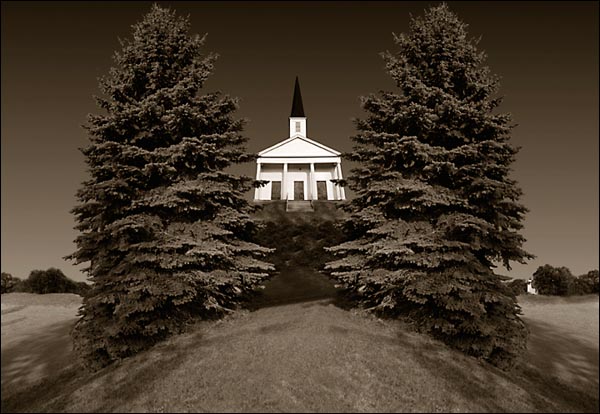
Lowdensbor, AL 1996 © Dan Biferie
Our exhibition is centered around the artist's latest works,
but it actually shows what Dan Biferie has been doing since the
beginning of his career. Among selected works from the 70s,
featuring the little known, provincial America, presented
observantly and from a critical distance, there are his latest
works, created by means of modern digital technology and marking
an interesting switch from a noble documentary to artistic
creation.
What Dan's latest pictures show is easy to identify.
Although they are mainly photographs which have been manipulated,
tampered with and digitally transformed, they remain legible as
far as the objects and the places they come from are concerned.
They could not have been taken anywhere else but in the United
States. This is America, even though it is different from the
country we have come to know watching the pictures of our global,
cosmopolitan pop-culture. One could even say that those pictures
are extremely American - due to their contents and relations with
the local photographic tradition, the great tradition of American
photography, that is to say, started by such people as Walker
Evans, Dorothea Lang and Russell Lee. Thus Biferie's art is
marked by high photographic culture, too, which is typical for
American culture and photography in general. Moreover, his works
are immaculately perfect. They possess all the features mentioned
above, and still more.

Three Crosses, PA © Dan Biferie
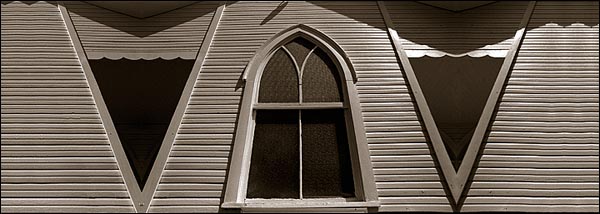
Tiverton, OH 2 © Dan Biferie
Most characteristic in his works is the far-reaching
reduction of certain elements or motifs of the picture - trees,
bushes, grass, a cornfield, water, a meadow, and wooden buildings
among them. Black-and-white or sepia-coloured pictures by Biferie
- even those digitally transformed - are simple because of the
noble simplicity of the objects, images or words which reach the
essence of things without unnecessary ornamentation. Those simple
things in the photographs, those elements of nature and culture
are connected by something more than just the fact that they have
been taken by the same author, that they are similar in the form
of the photographed objects or that they are alike in the form of
their representation, which is to say the angle of their frames,
their composition and the play of lights. It is most striking
that they are so forcefully present, that they exist in those
pictures so intensely that one can almost feel them. Here we
encounter the problem of time, deeply and inseparably connected
with photographic imagery. The intense existence of what we see
points to universal time, not to the time belonging to any
concrete "hic et nunc". The existence, the submergence in time of
places and things, of nature and culture, seems to be in Dan's
pictures their reason of being, "raison d'etre" - to exist and
survive, to take part in an undisturbed continuation. There is
nothing in this of nostalgic sentimentality, resulting from the
desire to stop time or retain the image of places that pass away
and which are changed by time as well as man. They show that the
connection of nature and culture lies deeper than on the level of
simple co-existence of buildings and landscapes or buildings set
next to landscapes. One ought to add here that most of these
buildings are old churches, usually wooden, scattered all over
provincial America. They are far diiferent from the typical
phenomena of American culture presented by mass media. The
existence of those buildings, their rooting in certain time and
tradition is to be seen both in Biferie's early works, created by
means of traditional photographic techniques, and in the works
which have been transformed by computer means. Dan manipulates
fragments of photographs in a subtle and discrete way. He
sometimes transforms fragments of a negative or a print, or puts
together an image from half-images so discretely and perfectly
that his manipulations become nearly invisible. Digital
instruments, however, allowed the author to liberate those
photographs from their transitory temporariness, their conretness
"hic et nunc" much more effectively than the usual, "analogue"
working method. We should stress that - paradoxically - the
images transformed digitally have not been deprived of their
authenticity or any documentary links between images and their
objects, if we agree that a document is something that confirms
the existence of something factual.
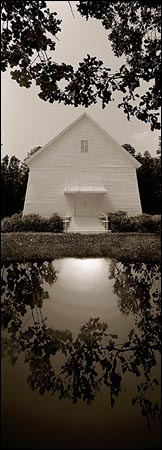
Cedar Rock, GA, 1995 © Dan Biferie
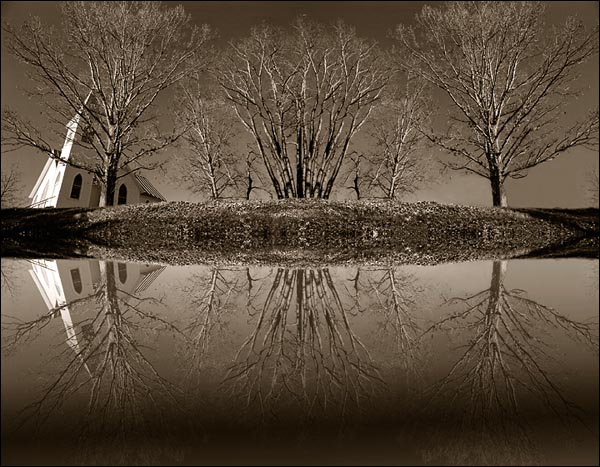
Pine Swamp, NC 2, 1999 © Dan Biferie
That is because the use of digital instruments freed the
Author from certain limitations of traditional, analogue
photography, any intrusion into which causes to a smaller or
larger degree the feeling of falseness. Discovering traces of
manipulation in an "analogue" photograph we feel it to be an
attack on a document and we feel that it is false - even if the
Author's intention was not to falsify but estheticize. But it is
different in the case of Dan Biferie's photos transformed
digitally in his unique way. He does not falsify anything and he
is not going to cheat his viewers. His digital operations are
often noticeable at a glance. And his intention is not a documentary, but a created picture of something he spotted,
beautiful in itself, but at the same time something that is
meaningful for him from the point of view of its selected motifs.
And it is their more than an obvious meaning that is the problem
which interests Biferie most.
The existence so moving in his works is not to be found in
some "abstract" natural and cultural surroundings. The material
culture of the buildings mingles with the spiritual culture of
those who had once built them as well as those who have since
then made use of their specific functions of temples. Those old,
modest buildings are surprisingly respected and cared for in
America, which one would have thought more sensitive to modernity
and the rush towards novelty. These churches become one of the
valuable elements forming cultural and national identity
independently of people's beliefs and worldviews. This respect
for tradition, typical of most Americans, perhaps because
American history is not very long, may be felt most clearly in
provincial parts of the U. S., where the pictures have been
taken.
Dan's art is also filled with respect towards photography
and reality - it gives the image of reality something that
existed in reality. It has never been directed against
photography, reality or its image. His artistic operations are
very conscious, both in terms of means and final results, and
they broaden the sphere of creation of photograph-based images.
Usually the esthetic use of digital techniques in transforming
photographic images takes place for different reasons. Digital
technology is often used "against" photography and its
limitations, moving far beyond the essence of a photographic
image (that is, its physical and ontological links with the
object) in the direction of forms of creation associated more
with a painter or draftsman than a photographer - or it is used
"against" reality which for various reasons does not fulfill the
expectations or demands of artists. Similar operations which
estheticize the image of reality appeared in the history of
photography before. The most clear example may be pictorialism
with its arsenal of specific, anti-photographic techniques used
to emulate works of fine arts. Modern computer techniques, which
may create images of non-existent objects and situations, enable
any stylization of an original, analogue photograph. The effects
of such operations frequently lead to a specific neopictorialism
in which tedious, manual pictorial techniques have been replaced
by computer techniques that allow us to perform equally deep
image manipulations. But Dan's works are decidedly antipictorial.
They are based on fundamental qualities of photographic pictures
scanned from a negative or a print. These qualities, like focus,
perspective, the play of lights and shadows and the "mechanical"
means of representation, additionally strengthen the role of
computer techniques which serve the photograph in a specific way.
Other operations which change the contents of the pictures
recorded on a negative do not "destruct" reality - they are not
directed against it although they manipulate its image. Those
pictures are composed of fragments of faithfully rendered images
of things which really existed in front of the camera in some
concrete "hic et nunc". In this respect they are documentary, but
they still remain ideal pictures. What they show could really
look as in Biferie's pictures... if the buildings were built in a slightly different fashion and if the trees, meadows and fields
slightly changed their position. His pictures are a projection of
an ideal.
In his art Biferie attempts to go beyond sensory impressions
and to convey his own personal feeling. Like a painter or a poet,
free in the choice of their imagery, Biferie wants to show his
own vision, his own internal image of things and his own
feelings, without giving up the realism of certain elements of
representation or a certain minimum of their documentary
character. New images, created partly with the help of a computer, are to tell us about certain places and experiences in
such a way as to make the object of experience legible, render
something that lies beyond a simple sensory perception and which
becomes precisely an experience, emotion or an expression of
cultural relations. Pure photography employed in a traditional
way has always resisted this type of contents because of its
documentary relations with objects. The transgression of this
resistance may be based on the intensification of a photographic
vision by formal, strictly photographic means (like focus, frame
composition, take and the use of value blotches) or, like in
pictorialism, on manipulation of the qualities of the picture,
its elements and contents.
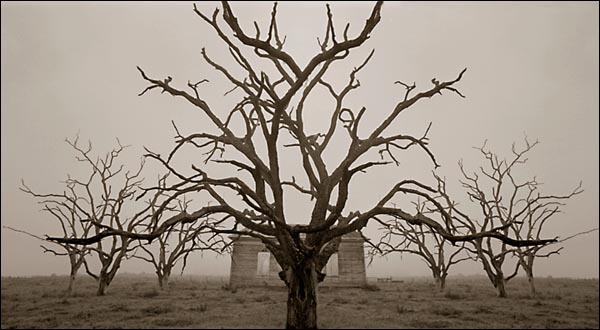
DeLand, FL, 1996 1996 © Dan Biferie

Geneva, FL, 1999 © Dan Biferie
In Dan Biferie's case digital instruments serve to broaden
creation and to present what he would like to express using a photographic image with all its advantages but without its
limitations. This strengthens his artistic autonomy in opposition
to the mechanical and documentary essence of the photographic
medium, although the images created in this way retain all
legible and unquestionable photographic values. It also fulfils
the need of probably every photographer and every artist, the
need to create one's own images and visions stimulated by
emotions, feeling and imagination, visions reaching beyond an
every-day contact with reality.
Setting in this exhibition Biferie's older works next to his
latest not only shows us the way the Author has come, but also
something more general, namely another possible approach to photography in the age of digital images. And as far as
photography is concerned this approach is rarely taken by
contemporary artists using digital instruments, although these
artists seem seduced by the seemingly unlimited possibilities of
manipulation in creating phantasmagoric virtual images. A great
value of Dan Biferie's works - not counting their artistic value
and great plastic beauty - is also their "didactic" aspect in
question, proving that a photographer may use the computer in his
own way without simultaneously betraying photography.
September 1999, Lech Lechowicz
translated by Maciej ¦wierkocki
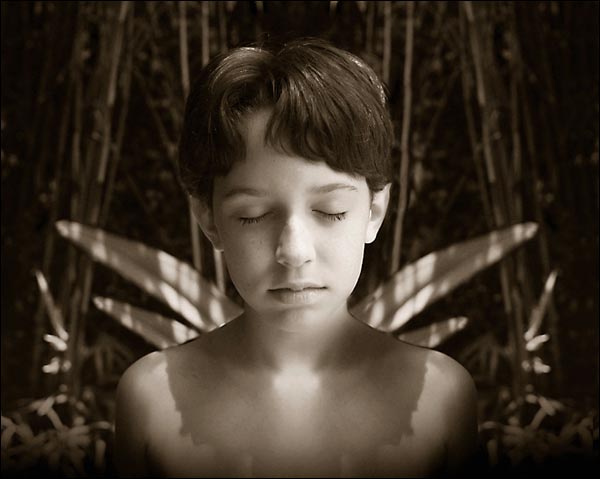
Pixie, 1998 © Dan Biferie
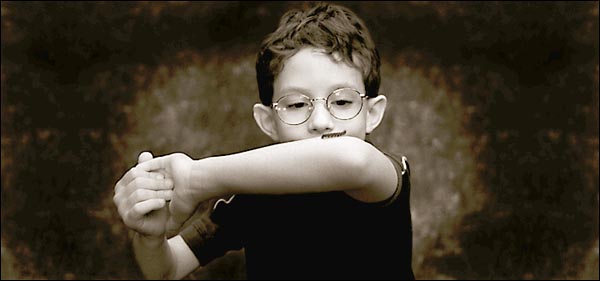
Robby with Caterpilla, 1998 © Dan Biferie
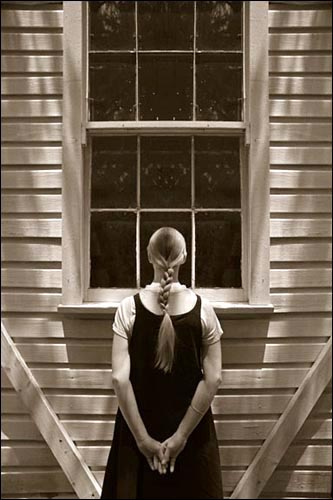
Kathy, 1999 © Dan Biferie
Look also:
ZONEZERO
AMERICAN VISION
Copyright ©1999 Dan Biferie, Lech Lechowicz, Galeria FF £DK